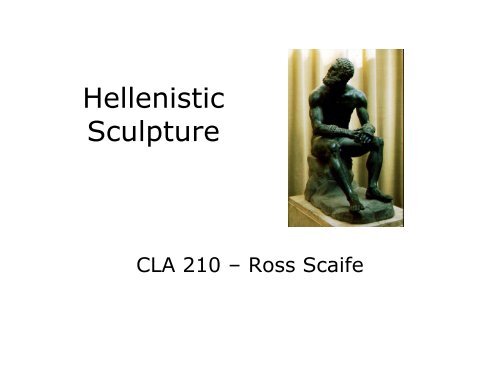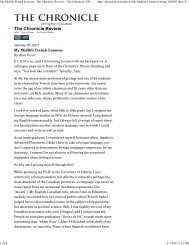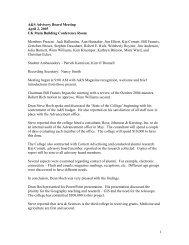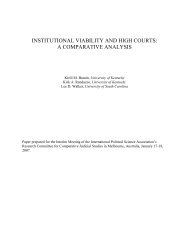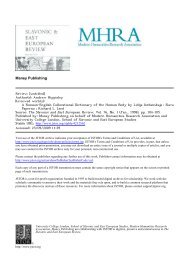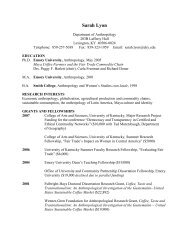Hellenistic Sculpture
Hellenistic Sculpture
Hellenistic Sculpture
Create successful ePaper yourself
Turn your PDF publications into a flip-book with our unique Google optimized e-Paper software.
<strong>Hellenistic</strong><br />
<strong>Sculpture</strong><br />
CLA 210 – Ross Scaife
Crouching Aphrodite<br />
Cnidian Aphrodite<br />
Roman marble copy of<br />
original c. 250-200 BCE
4 th century Greece<br />
• 399: Socrates sentenced to death at Athens for impiety and<br />
corrupting the youth<br />
• 387: Philosopher Plato writes the "Symposium"<br />
• 384: Philosopher Aristotle born<br />
• 359: Philip II, father of Alexander the Great, becomes regent of<br />
Macedonia<br />
• 351: Demosthenes delivers the first of four "Philippics" against Philip<br />
II<br />
• 338: Philip II defeats combined forces of Athens and Thebes<br />
• 336: Philip II assassinated, Alexander assumes throne<br />
• 333: Alexander defeats Persian emperor Darius at Issus<br />
• 330: Babylon, Persepolis and Susa fall to Alexander<br />
• 327: Alexander’s forces invade India (but later mutiny)<br />
• 323: Death of Alexander the Great
Socrates<br />
Aristotle<br />
Era of protraiture<br />
Demosthenes
Barberini Faun (Munich)<br />
ca. 200 BCE
Satyrs (party animals)
Satyrs (ithyphallic)
Market Woman<br />
Drunken Old Woman
The Terme Boxer<br />
(Bronze, c. 200-50 BCE)
The Terme Boxer<br />
(Bronze, c. 200-50 BCE)
The Terme Boxer<br />
(Bronze, c. 200-50 BCE)
Nike of Samothrace
Nike of Samothrace<br />
• Found in Samothrace (north Aegean), now in<br />
Louvre, Paris.<br />
• Likely to be Rhodian (base is of Rhodian<br />
marble).<br />
• Dated to ca. 190 B.C. (associated pottery).<br />
• Probably celebrated sea victory of Rhodes v.<br />
Antiochos IV Epiphanes (of Syria).<br />
• Placed within an open fronted building, on a<br />
base shaped like the prow of a ship set in<br />
water, paved with slabs and rocks to imitate<br />
the shore on which the victorious ship would<br />
have landed.
Nike of<br />
Samothrace
Nike of Samothrace<br />
Ancient Greek marble sculpture of winged Victory (h. c. 2 m; Paris, Louvre). It may have<br />
been made by a pupil or follower of Lysippos or Skopas and was perhaps commissioned by<br />
Demetrios I of Macedonia between 295 and 287 bc, or it may date to c. 200 bc. It was<br />
discovered in 1863 on the island of Samothrace during a series of excavations conducted<br />
by Charles Champoiseau. The statue was taken to Paris, where it underwent restoration to<br />
replace the wings and parts of the drapery, which were found in fragments. It was first<br />
exhibited at the Musée du Louvre in the Salle des Caryatides. In 1866 another campaign of<br />
excavations was organized on the island, but this proved fruitless. Champoiseau himself<br />
returned to Samothrace in 1879 and found the fragments of a rostrate prow, which had<br />
served as the pedestal of the statue. The fragments were sent to Paris, and in 1884 the<br />
Nike, raised on the prow, was placed with great scenographic effect at the head of the<br />
Escalier Daru, where it can still be admired. Although a later work, it has been compared to<br />
the sculptures of the Parthenon. Much of its fame is due to its suggestive placement, which<br />
brings out its dramatic qualities; these are perhaps emphasized by the absence of the arms<br />
and head. Many hypotheses have been advanced concerning the position of the arms and<br />
the objects originally held by the statue. It used to be supposed that the figure held a<br />
trumpet or a laurel crown in the right hand. In 1950 new excavations produced fragments of<br />
the right hand, and in the same year the thumb and part of the index finger of the same<br />
hand were identified among some pieces found at Samothrace in 1873 and 1875 by the<br />
Austrians and taken to the Kunsthistorisches Museum in Vienna. These finds suggest that<br />
the Nike was holding nothing at all in her hand, or at most a fluttering metal fillet between<br />
the thumb and index finger. (Grove Art Online)
Laocoön
Laocoön and his sons<br />
• Now in the Vatican, discovered in 1506 on the<br />
Esquiline Hill in Rome.<br />
• Dated ca. 100 CE.<br />
• Perhaps the same statue by three Rhodian<br />
sculptors--Hagesandros, Polydoros, and<br />
Athenadoros, praised by Pliny (NH 36.37),<br />
who saw it in the house of the emperor Titus.<br />
• Shows the Trojan priest Laocoön and his two<br />
sons, attacked at an altar by two large<br />
serpents (for the story see Vergil, Aeneid<br />
2.199-233).
Laocoön
Laocoön and his sons<br />
Marble sculptural group that represents an episode recounted in Virgil's Aeneid (II.199-<br />
231), in which a sea monster attacks the Trojan priest Laokoon and his two young sons in<br />
front of the walls of Troy. The date and provenance of the work (Rome, Vatican, Cortile<br />
Belvedere; h. 2.42 m) is disputed. Its identification with the Laokoon by the Rhodian<br />
sculptors Hagesandros, Polydoros and Athenodoros, said by Pliny (Natural History<br />
XXXVI.iv.37) to have adorned the Palace of Titus at Rome, has been questioned because<br />
Pliny claimed that the latter was made from a single block of marble, while the extant<br />
group is made from several. However, stylistic resemblances between the surviving group<br />
and the sculptures in the grotto at Sperlonga actually signed by Hagesandros, Polydoros<br />
and Athenodoros have caused many scholars to accept it as the Laokoon mentioned by<br />
Pliny. They regard it as a work of the 1st century ad in the stylistic tradition of the<br />
sculptures of <strong>Hellenistic</strong> Pergamon, but perhaps also inspired by statues on Rhodes. The<br />
sculpture was discovered on 14 January 1506 in a vineyard not far from the basilica of S<br />
Maria Maggiore in Rome, and was placed in a niche in the Cortile del Belvedere in the<br />
Vatican. In 1797 it was moved to Paris, and later put on display in the Musée Central des<br />
Arts until 1815; the following year it was returned to its original setting in the Vatican.<br />
When the group was found it lacked the right arm of Laokoon and the right hands of his<br />
sons, but during the 1530s Giovanni Angelo Montorsoli replaced the arm in terracotta,<br />
although its position is not certain. In a copy of the group by the sculptor Baccio Bandinelli<br />
(c. 1520-22; Florence, Uffizi) the arm is bent, as it probably was in antiquity. A terracotta<br />
arm extending upwards, perhaps not the one by Montorsoli, remained on the sculpture<br />
from the second half of the 16th century until it was moved to Paris. For centuries the<br />
Laokoon enjoyed enormous fame, equal to that of the Apollo Belvedere (Rome, Vatican,<br />
Mus. Pio-Clementino). It was not only copied by artists from the earliest days of its<br />
discovery, but also profoundly influenced the anatomy, poses and mood of their work.<br />
(Grove Art Online)


